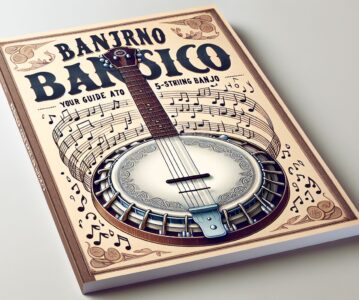Are you ready to pick up a new instrument and create toe-tapping melodies? Look no further than the banjo! A quintessential American instrument, the banjo’s distinct sound has been a cornerstone of folk, bluegrass, and country music for generations. Whether you’re a fan of Earl Scruggs or Mumford & Sons, learning the banjo could be your ticket to joining the ranks of famous banjo pickers. In this beginner’s guide, we’ll walk you through the basics of the 5-string banjo, from its anatomy to playing techniques, to help kickstart your banjo journey.
Introducing the Banjo
The banjo is a fascinating instrument with a unique sound that instantly transports listeners to the heart of America. With a circular body and a long neck, it may look similar to a guitar or ukulele at first glance, but its sound and playing style set it apart. Banjos typically have five strings, although there are variants with four, six, or even more strings.
The 5-string banjo is the most common and versatile type. The strings are usually tuned to an open G chord, from the highest-pitched string to the lowest: g-D-G-B-D. This open G tuning allows beginners to easily play chords and literally “strum” right out of the gate.
Anatomy of a Banjo
Before we dive into playing, let’s familiarize ourselves with the main components of a typical 5-string banjo:
- Head: The banjo’s head is a tightly stretched skin-like material, traditionally made from animal hide or synthetic materials like plastic or fiberskin. It serves as both a resonator and a striking surface.
- Bridge: A wooden or metal piece that supports the strings, raising them slightly above the head. The bridge’s placement is crucial for proper intonation and sound quality.
- Neck: The long, slender portion of the banjo that houses the frets and the tuning pegs. It usually extends from the body and is where you place your left hand to create different notes.
- Frets: Thin metal strips embedded along the neck of the banjo, typically made from nickel-silver. These frets divide the neck into specific intervals to help you play in tune.
- Resonator: In many banjos, the circular wooden body has a removable back panel called a resonator. This component serves to project the sound forward, making it louder and more vibrant.
- Tuning Pegs: Located at the top of the neck, these pegs are used to tighten or loosen the strings, allowing you to adjust their pitch. Turning the peg clockwise raises the pitch, while turning it counterclockwise lowers the pitch.
Playing Techniques
Now that we have our banjo fundamentals down, it’s time to start making some music! Here are a few essential playing techniques to get you strumming:
- Fingerpicking: Fingerpicking is one of the most common techniques used to play melodies, chords, and solos on the banjo. It involves using your thumb, index, and middle fingers to pluck the strings individually for precise control and rich tones.
- Scruggs Style: Named after the legendary Earl Scruggs, this three-finger picking technique revolutionized banjo playing. By using picks on their fingertips, players alternate between thumb, index, and middle finger to create a rolling, melodic sound.
- Chords: Chords are the building blocks of music, and the banjo is no exception. As a beginner, start by learning basic open chords like G, D, and C. Experiment with strumming these chords in different patterns to familiarize yourself with the banjo’s unique sound.
- Slides and Hammer-ons: Slides and hammer-ons are useful techniques for adding flair to your banjo playing. A slide involves smoothly transitioning from one note to another by sliding your finger up or down the neck. A hammer-on occurs when you press a finger onto a string, producing a new note without plucking the string.
Cultivating Your Banjo Skills
As with any new instrument, consistent practice is key to mastering the banjo. Here are a few tips to help you along your musical journey:
- Find a Teacher or Online Lessons: Learning from an experienced banjo player or online lessons can provide guidance, feedback, and structured learning.
- Start Slow and Steady: Begin with basic techniques and simple melodies before diving into more complex songs. Developing a strong foundation will make future challenges more achievable.
- Practice Properly: Dedicate regular practice sessions to build muscle memory, finger strength, and coordination. Shorter, focused practice sessions are generally more effective than sporadic, longer sessions.
- Jam with Others: Joining a local jam session or playing along with recorded music is a great way to improve your banjo skills, learn new techniques, and gain musical confidence.
- Explore Different Genres: Experiment with various genres like bluegrass, folk, and country to expand your banjo playing style and broaden your musical horizons.
Conclusion
With its lively sound and rich heritage, the 5-string banjo offers endless musical possibilities to beginners willing to dive in and learn. By understanding the instrument’s anatomy, practicing essential playing techniques, and fostering a regular practice routine, you’ll steadily progress on your banjo journey. So, what are you waiting for? Dust off that old banjo or grab a new one, and let the unwavering strums of the 5-string banjo become your musical narrative. Happy picking!


